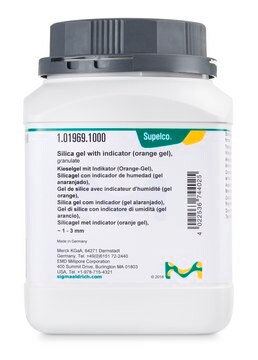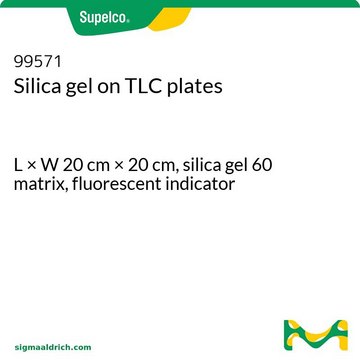60765
Silica gel
high-purity grade, with ~15% calcium sulfate and fluorescent indicator, GF254, suitable for thin layer chromatography (TLC)
About This Item
Recommended Products
grade
high-purity grade
Quality Level
form
powder
quality
with ~15% calcium sulfate and fluorescent indicator
manufacturer/tradename
Sigma-Aldrich
technique(s)
thin layer chromatography (TLC): suitable
surface area
500 m2/g
particle size
<20 μm
>632 mesh
pore size
0.8 cm3/g pore volume
60 Å pore size
bp
2230 °C
mp
>1600 °C
SMILES string
O=[Si]=O
InChI
1S/O2Si/c1-3-2
InChI key
VYPSYNLAJGMNEJ-UHFFFAOYSA-N
Looking for similar products? Visit Product Comparison Guide
General description
a. Aquagel - pores are filled with water
b. Xerogel - by the process of evaporation, aqueous phase in the pores are removed
c. Aerogel - solvent is removed by supercritical extraction
Application
- Chromatographic Separation: Silica gel is widely used as a stationary phase in chromatography for the separation of various chemical compounds. Innovations in silica gel modification, such as pentabromobenzyl group-modified silica gel, have enhanced the separation efficiency for metabolites like nicotinamide. This application is critical for pharmaceutical analysis and metabolomics studies, providing high precision and accuracy in the quantification of biologically relevant molecules (Ozaki et al., Analytical Biochemistry, 2022).
- Environmental Pollutant Detection: Silica gel is used to create molecularly imprinted polymers (MIPs) that selectively recognize and bind environmental pollutants. A notable application involves the embedding of quantum dots in molecularly imprinted silica gel to detect aminoimidazo-azaarenes (AIAs) in food samples. This method offers high selectivity and sensitivity, making it a powerful tool for food safety and environmental monitoring (Qiao et al., Current Analytical Chemistry, 2021).
Storage Class Code
11 - Combustible Solids
WGK
nwg
Flash Point(F)
Not applicable
Flash Point(C)
Not applicable
Personal Protective Equipment
Regulatory Listings
Regulatory Listings are mainly provided for chemical products. Only limited information can be provided here for non-chemical products. No entry means none of the components are listed. It is the user’s obligation to ensure the safe and legal use of the product.
ISHL Indicated Name
Substances Subject to be Indicated Names
ISHL Notified Names
Substances Subject to be Notified Names
JAN Code
60765-1KG:4548173944623
60765-VAR:
60765-BULK:
60765-250G:4548173944630
Choose from one of the most recent versions:
Already Own This Product?
Find documentation for the products that you have recently purchased in the Document Library.
Customers Also Viewed
Our team of scientists has experience in all areas of research including Life Science, Material Science, Chemical Synthesis, Chromatography, Analytical and many others.
Contact Technical Service


